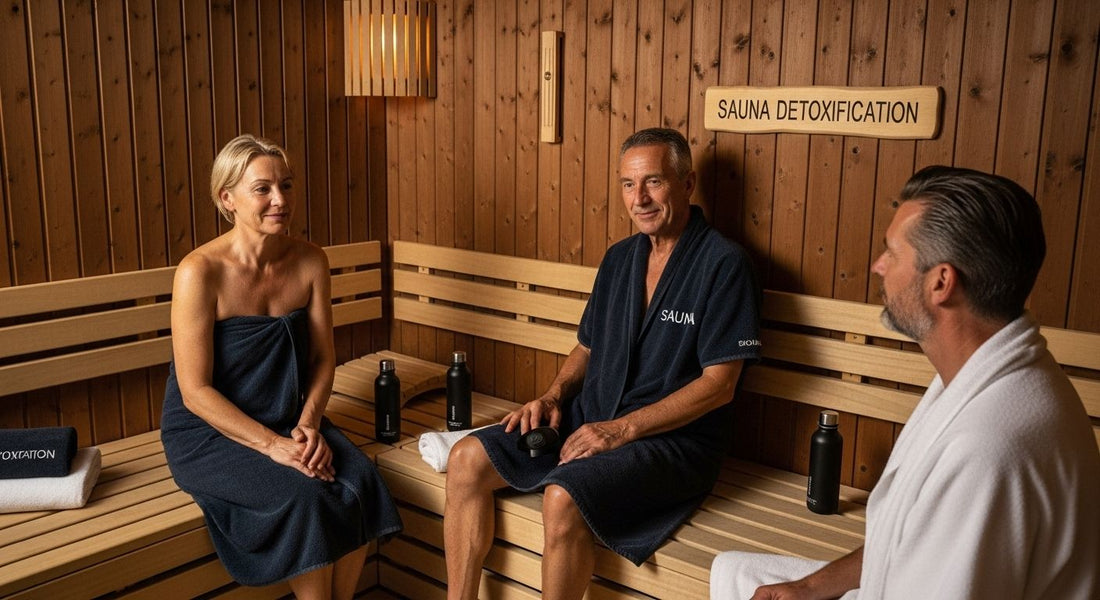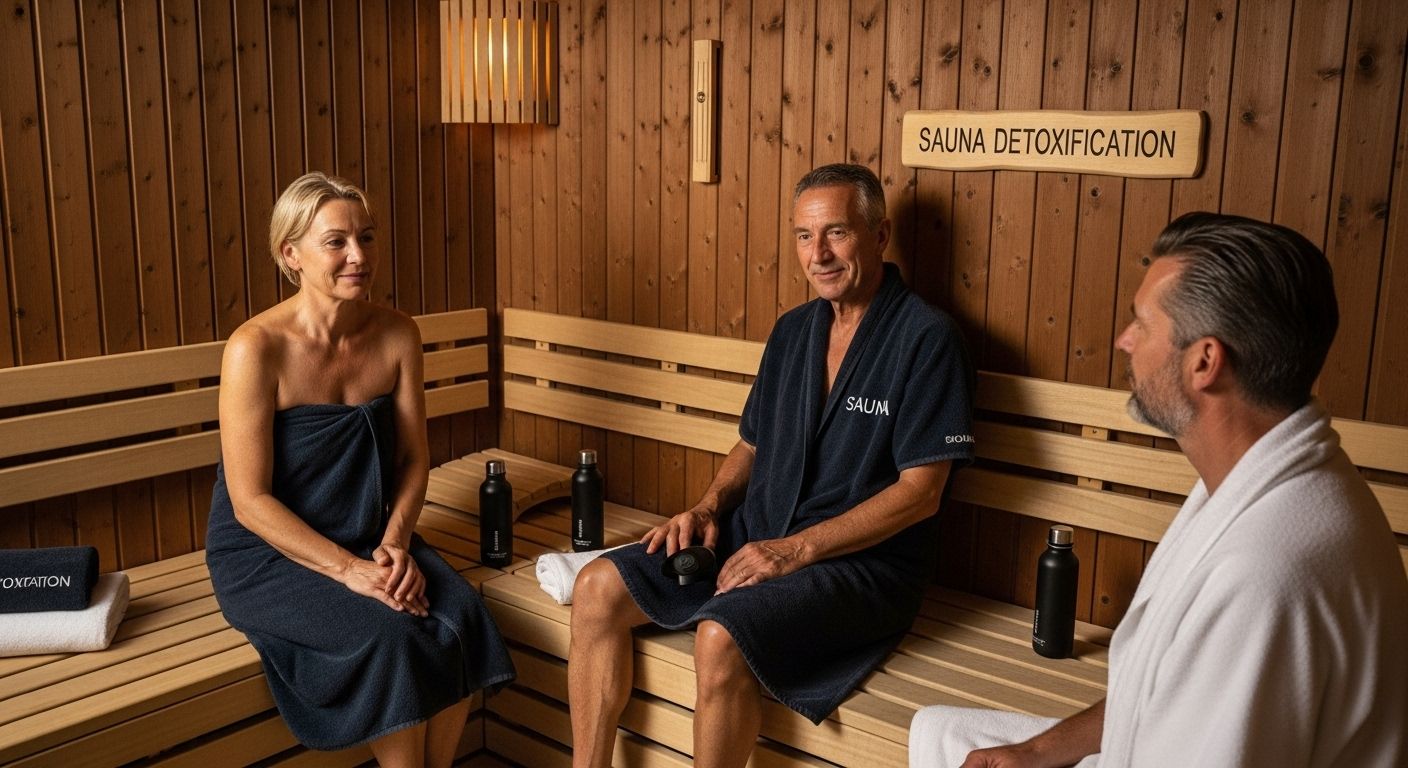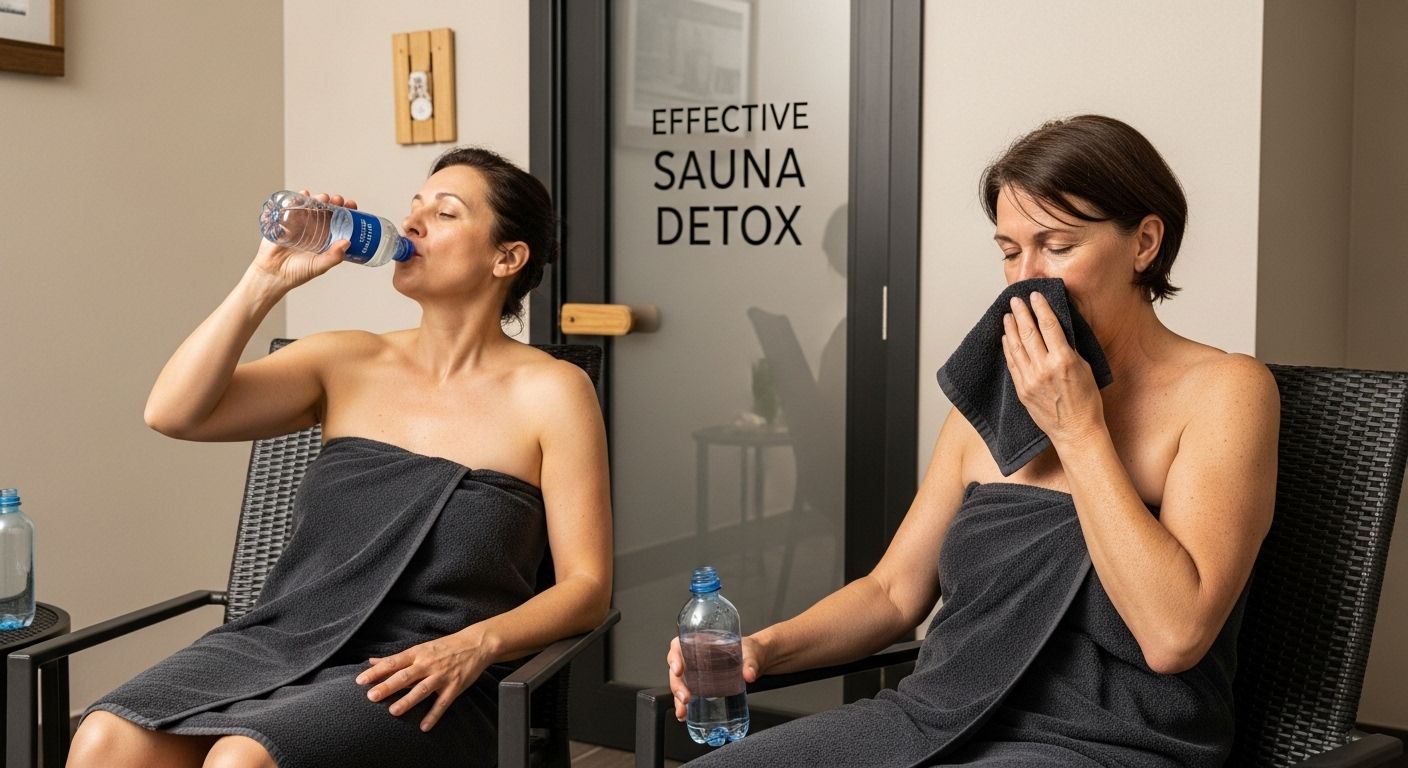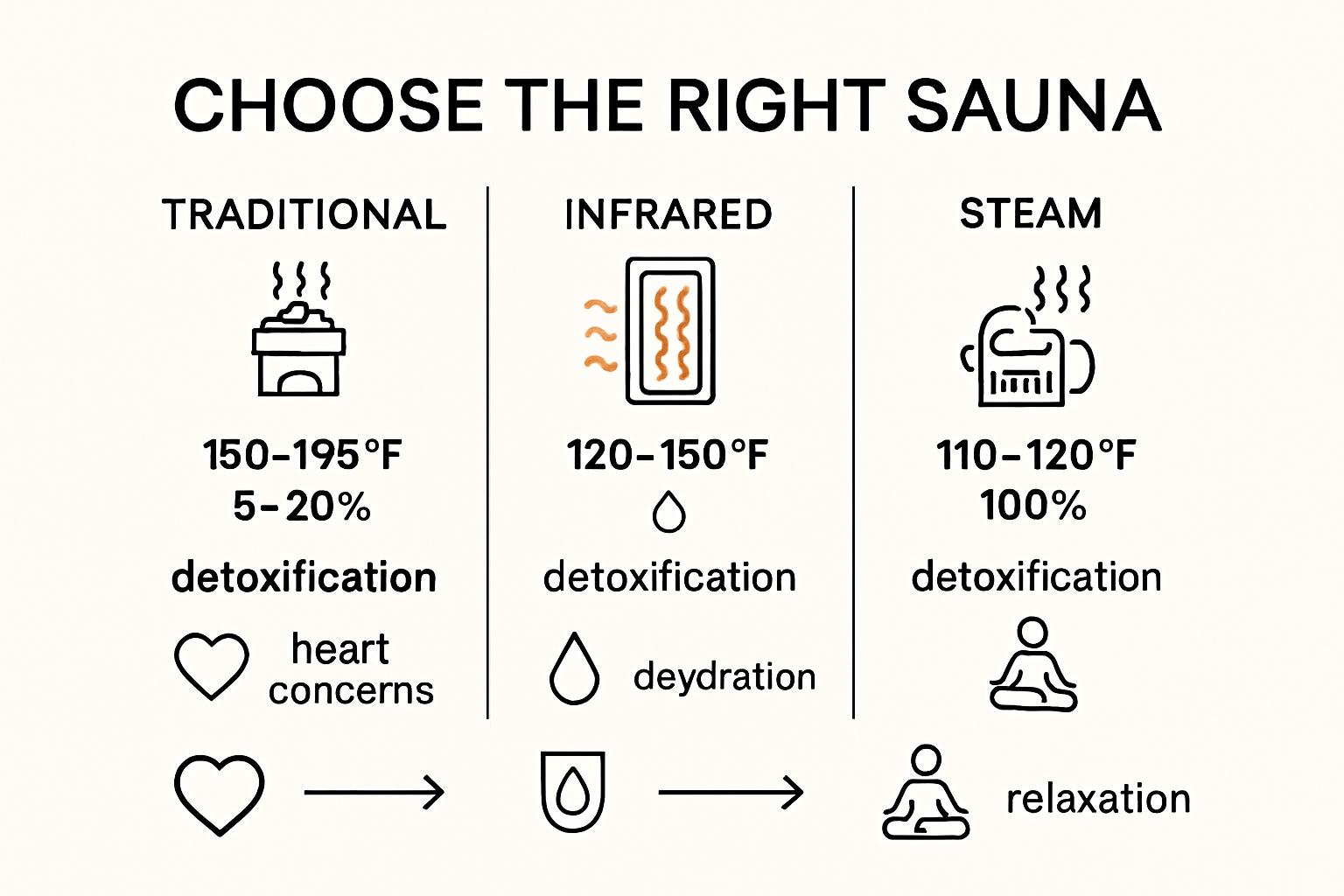
Understanding the Sauna Detoxification Process for Wellness

Sauna detox has captured attention as a simple way to support health, with people flocking to saunas for their supposed cleansing power and sense of relaxation. But most people do not realize that your skin temperature can jump to a scorching 104°F within minutes of stepping inside. The real surprise comes from the science, which shows the biggest benefits might actually be in how heat stress supports your heart, immune system, and even your mood—not just in sweating out toxins.
Table of Contents
- How Sauna Detoxification Works In The Body
- Top Benefits Of The Sauna Detoxification Process
- Practical Steps For Effective Sauna Detoxification
- Choosing The Right Sauna For Optimal Detox
Quick Summary
| Takeaway | Explanation |
|---|---|
| Hydration is crucial before sauna use | Drink plenty of water before, during, and after to prevent dehydration during intense sweating. |
| Sauna sessions should be limited to 10-20 minutes | Beginners should start with shorter durations and gradually increase as tolerance builds, prioritizing comfort. |
| Consult healthcare professionals before use | Those with cardiovascular issues or chronic conditions should seek medical advice before starting sauna routines. |
| Regular sauna use is linked to cardiovascular benefits | Frequent sauna sessions support vascular health by improving blood circulation and reducing disease risk. |
| Choose the right sauna type for your needs | Different sauna types offer unique benefits; select based on personal comfort and specific health goals like detoxification. |
How Sauna Detoxification Works in the Body
The human body has an intricate system for managing toxins and maintaining internal balance. Sauna detoxification represents a holistic approach to supporting the body’s natural elimination processes through controlled heat exposure. Understanding the physiological mechanisms behind this process reveals how sweating and thermal stress can potentially contribute to wellness.
The Hormonal Response to Heat Stress
When exposed to high temperatures in a sauna, the body undergoes significant hormonal changes as a protective and adaptive mechanism. Research published in PubMed demonstrates that sauna exposure triggers the secretion of several key hormones including noradrenaline, antidiuretic hormone, growth hormone, and prolactin. These hormonal shifts represent the body’s sophisticated response to thermal stress.
The hormonal cascade initiates a series of physiological reactions designed to help the body maintain homeostasis. Noradrenaline, for instance, increases alertness and metabolic rate, while growth hormone supports tissue repair and cellular regeneration. These hormonal changes are temporary and typically return to baseline levels within a few hours after sauna use.
Sweating and Toxin Elimination
Sweating is often considered a primary mechanism for toxin elimination during sauna sessions. However, the scientific understanding of this process is nuanced. European research in toxicology suggests that sweat can contain trace amounts of heavy metals such as arsenic, cadmium, lead, and mercury. The excretion rates through sweating can sometimes match or even exceed those observed in urine.
It is crucial to understand that while sweating may contribute to toxin elimination, the body’s primary detoxification organs remain the liver and kidneys. Poison.org research indicates that the role of sweating in comprehensive detoxification is relatively minimal. The sauna should be viewed as a complementary wellness practice rather than a standalone detoxification solution.
The process of sweating in a sauna environment goes beyond simple toxin elimination. It also supports improved circulation, promotes relaxation, and can help reduce muscle tension. The elevated body temperature stimulates blood flow, potentially enhancing the body’s natural metabolic processes and supporting overall physiological function.
While the direct detoxification benefits continue to be studied, the holistic wellness advantages of regular sauna use are increasingly recognized. The combination of hormonal responses, potential toxin elimination, and overall stress reduction makes sauna sessions a valuable component of a comprehensive wellness strategy.
Individuals considering sauna detoxification should approach it as part of a balanced health routine. Staying hydrated, listening to your body, and consulting healthcare professionals can help maximize the potential benefits while ensuring safe practice.
Top Benefits of the Sauna Detoxification Process
The sauna detoxification process offers more than just a relaxing experience. Its potential health benefits extend across multiple physiological systems, making it an increasingly popular wellness practice. Understanding these benefits can help individuals make informed decisions about incorporating sauna sessions into their health routine.
Cardiovascular and Circulatory System Enhancement
Research published in Mayo Clinic Proceedings reveals compelling evidence of sauna bathing’s positive impact on cardiovascular health. Regular sauna use is associated with significant reductions in the risk of vascular diseases, including high blood pressure and cardiovascular complications. The thermal stress experienced during sauna sessions triggers important physiological responses that support heart health and circulatory function.
The heat exposure causes blood vessels to dilate, improving overall blood circulation and potentially lowering blood pressure. This enhanced circulatory response can contribute to better oxygen delivery to tissues and more efficient metabolic processes. Athletes and fitness enthusiasts may find particular value in these cardiovascular benefits, as improved circulation supports muscle recovery and overall physical performance.
Immune System and Stress Reduction
PubMed research indicates that sauna therapy extends beyond simple relaxation, offering potential therapeutic benefits for various health conditions. The controlled heat environment stimulates the body’s natural immune responses, potentially helping individuals manage stress and support overall wellness.
The heat stress experienced during sauna sessions triggers the production of heat shock proteins, which play a crucial role in cellular protection and repair. These proteins help the body respond more effectively to environmental stressors and may contribute to improved resilience against inflammation and oxidative stress. Moreover, the meditative and calming nature of sauna bathing can help reduce psychological stress, promoting mental relaxation and potentially improving sleep quality.
Metabolic and Detoxification Support
While the National Capital Poison Center cautions against overstating detoxification claims, sauna use can support the body’s natural elimination processes. The intense sweating induced by sauna sessions may help flush out trace amounts of environmental toxins and support metabolic functions.
The elevated body temperature during sauna use can temporarily boost metabolic rate, potentially supporting weight management efforts. Additionally, the increased sweating can help cleanse the skin, unclog pores, and promote a natural glow. However, it is essential to maintain proper hydration and view sauna sessions as a complementary wellness practice rather than a standalone solution.
Individuals considering sauna detoxification should approach it as part of a holistic health strategy. Consulting healthcare professionals, staying hydrated, and listening to your body are crucial steps in maximizing the potential benefits while ensuring safe and effective practice. While the scientific community continues to explore the full range of sauna benefits, current research suggests that regular, moderate sauna use can be a valuable addition to a comprehensive wellness routine.
Practical Steps for Effective Sauna Detoxification
Maximizing the potential benefits of sauna detoxification requires a strategic and informed approach. Understanding the proper techniques and precautions can help individuals safely integrate sauna sessions into their wellness routine and optimize their potential health outcomes.
Preparation and Hydration Strategies
Research published in Evidence-Based Complementary and Alternative Medicine emphasizes the critical importance of proper hydration during sauna detoxification. Before entering a sauna, individuals should drink sufficient water to prepare their body for the intense sweating process. The recommended approach involves consuming water steadily before, during, and after the sauna session to replace lost fluids and support the body’s natural elimination processes.
Prior to a sauna session, light stretching and gentle movement can help prepare the body for heat exposure. Wearing lightweight, breathable clothing or appropriate sauna attire can enhance comfort and facilitate more effective sweating. It is advisable to remove any metal jewelry or accessories that might become uncomfortably hot during the session.
Session Duration and Frequency Guidelines
The Mayo Clinic recommends keeping sauna sessions relatively short, typically between 10 to 20 minutes. Beginners should start with shorter durations and gradually increase their time as they become more comfortable with the heat exposure. Listening to one’s body and avoiding overexertion is crucial for a safe and effective experience.
For individuals new to sauna detoxification, it is recommended to begin with one to two sessions per week, allowing the body to adapt to the thermal stress. More experienced users might incorporate three to four sessions weekly, always maintaining awareness of their physical responses. Spacing out sauna sessions and allowing adequate recovery time between them helps prevent potential strain on the cardiovascular system.
Safety Precautions and Health Considerations
Healthcare professionals strongly advise against using saunas under certain conditions. Individuals with cardiovascular issues, pregnant women, and those with chronic health conditions should consult their healthcare provider before beginning a sauna detoxification program. The Mayo Clinic specifically warns against consuming alcohol before or during sauna sessions, as this can significantly increase risks of dehydration and cardiovascular stress.
After each sauna session, individuals should focus on gradual cooling and continued hydration. Drinking two to four glasses of water helps replenish lost fluids and supports the body’s natural detoxification processes. Light, nutritious snacks can help restore electrolyte balance and provide essential nutrients lost during sweating.
While sauna detoxification offers potential wellness benefits, it should be viewed as a complementary practice within a broader health strategy. Maintaining a balanced diet, regular exercise, and proper sleep are equally important for comprehensive wellness. Individuals should approach sauna use with mindfulness, paying close attention to their body’s signals and adjusting their practice accordingly.
By following these practical steps and maintaining a thoughtful, informed approach, individuals can safely explore the potential benefits of sauna detoxification. The key lies in understanding personal health limitations, staying hydrated, and viewing sauna sessions as one component of a holistic wellness routine.
To help readers safely start and maintain sauna detoxification, here is a checklist summarizing practical steps and precautions highlighted in the article.
| Step or Precaution | Follow Before | During | After |
|---|---|---|---|
| Drink water to hydrate | ✓ | ✓ | ✓ |
| Wear lightweight, breathable clothing | ✓ | ||
| Remove metal jewelry/accessories | ✓ | ||
| Limit session to 10–20 minutes | ✓ | ||
| Listen to your body’s signals | ✓ | ||
| Gradual cooling and continued hydration | ✓ | ||
| Eat light, nutritious snacks | ✓ | ||
| Avoid alcohol consumption | ✓ | ✓ | |
| Consult healthcare professional if needed | ✓ |

Choosing the Right Sauna for Optimal Detox
Selecting the appropriate sauna is a critical decision for individuals seeking to maximize their detoxification and wellness potential. Different sauna types offer unique characteristics that can significantly impact the overall effectiveness of heat therapy and potential health benefits.
Below is a comparison table summarizing key features and considerations of different sauna types discussed, helping readers choose the sauna best suited to their goals and needs.
| Sauna Type | Heat Source | Temperature Range | Unique Benefits | Potential Considerations |
|---|---|---|---|---|
| Traditional Finnish | Wood/Electric Heater | High (up to 104°F) | Intense heat and humidity; classic sauna experience | Higher humidity; may not suit heat-sensitive |
| Infrared | Infrared Light Waves | Lower (often 100–105°F) | Deep tissue penetration; operates at lower temps | Not as humid; EMF level considerations |
| Steam | Steam Generator | Varies | High humidity; may feel more comfortable for some | Less intense heat; requires more maintenance |
| Portable Infrared | Infrared Light Waves | Lower | Convenient for home use; easy setup | May offer less intense experience |
Types of Saunas and Their Unique Characteristics
Harvard Health highlights that saunas can cause skin temperatures to rise to approximately 104°F within minutes, triggering significant physiological responses. Traditional saunas typically use wood or electric heaters to create dry heat, while infrared saunas use light waves to generate heat directly absorbed by the body. Each type offers distinct advantages for detoxification and wellness.
Traditional Finnish saunas provide intense heat and humidity, creating a more intense sweating experience. Infrared saunas operate at lower temperatures but penetrate body tissues more deeply, potentially offering more targeted therapeutic benefits. Steam saunas provide high humidity environments that can feel more comfortable for individuals sensitive to dry heat.
Cardiovascular Considerations and Temperature Recommendations
Research from Harvard Health emphasizes the importance of carefully selecting sauna temperatures. Optimal sauna environments typically range between 100°F to 105°F, allowing blood vessels to dilate and potentially lower blood pressure. Individuals with cardiovascular conditions should consult healthcare professionals and consider their specific health requirements when choosing a sauna.
Interesting findings from a Finnish study referenced by Harvard Health revealed that men who used saunas four to seven times weekly experienced a 31% lower risk of cardiovascular disease compared to those using saunas less frequently. This underscores the potential long-term health benefits of consistent, appropriate sauna use.
Personal Health and Sauna Selection Factors
When selecting a sauna, consider factors beyond heat type. Size, material construction, energy efficiency, and personal comfort play crucial roles. Wooden saunas offer natural aesthetics and excellent heat retention, while portable infrared models provide convenience for home use. Ceramic or carbon fiber heating elements in infrared saunas can provide more even heat distribution.
Individuals with specific health goals should evaluate sauna features that align with their wellness objectives. Those seeking deeper tissue penetration might prefer infrared technology, while those wanting a more traditional experience might choose Finnish-style wood-burning saunas. Factors such as EMF levels, ease of maintenance, and spatial requirements should also influence the decision.
Pre-purchase considerations should include consulting healthcare providers, understanding personal heat tolerance, and considering available space. Budget considerations are important, but prioritizing quality and safety remains paramount. Some individuals might benefit from trying different sauna types through gym memberships or wellness centers before making a significant investment.
By carefully evaluating personal health needs, understanding different sauna technologies, and considering expert recommendations, individuals can select a sauna that supports their detoxification and wellness journey. The right sauna becomes more than an appliance - it transforms into a personalized wellness tool supporting holistic health objectives.

Frequently Asked Questions
What are the benefits of sauna detoxification?
Sauna detoxification can enhance cardiovascular health, improve immune system function, support metabolic processes, and promote relaxation. Regular sauna use may reduce the risk of cardiovascular diseases and improve overall wellness.
How often should I use a sauna for detoxification?
Beginners should start with one to two sessions per week, while more experienced users may increase to three to four sessions weekly. It’s important to listen to your body and gradually adjust frequency based on comfort and tolerance.
What precautions should I take before using a sauna?
Before using a sauna, ensure proper hydration by drinking water, avoid alcohol consumption, and consult a healthcare professional if you have any pre-existing health conditions, especially cardiovascular issues.
How does sweating contribute to detoxification in a sauna?
While sweating can help eliminate trace amounts of toxins, the body’s primary detoxification organs are the liver and kidneys. Sweating in a sauna also promotes improved circulation and relaxation, contributing to overall wellness.
Ready to Experience the Full Benefits of Sauna Detoxification at Home?
If you have been inspired by the proven cardiovascular, immune, and relaxation benefits explored in our article, it is time to make those wellness goals a reality. Many readers struggle with finding effective and safe ways to support toxin elimination, improve circulation, and manage stress. At Best Life Sauna, you will discover a curated selection of premium sauna solutions that align with the exact principles discussed here—whether you are intrigued by the deep tissue benefits of infrared technology or want to recreate the rejuvenating environment of a traditional Finnish sauna right at home.

Take the next step on your wellness journey. Browse Best Life Sauna for exclusive offers, customer-inspired product reviews, and expert guidance so you can confidently choose the ideal sauna for your unique needs. Start feeling the difference of true sauna detoxification today—experience better energy, improved skin, and pure relaxation when you act now.

